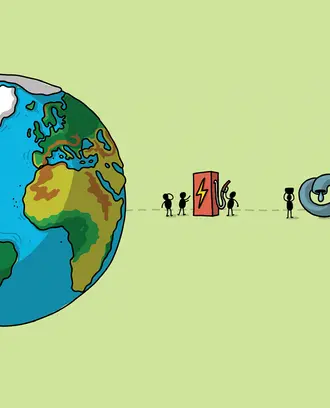Credit: Andrii Chagovets/iStock | En-ROADS climate simulator
This digital tool helps business leaders visualize climate actions
Businesses are some of the most powerful institutions in society. Companies influence popular opinion and policies through the products and services they offer, the advertising and communications that reach the public, and the lobbying and financial support they provide to candidates and ballot issues.
Businesses also play an important role in shaping the conversation around climate and sustainability and in determining what actions to take. But while it’s easy to see the devastating effects of climate change today — raging wildfires, massive floods, harsh droughts, and extreme storms — it’s harder to understand the underlying drivers and determine where and how climate actions fit in a corporate strategy. That’s where the En-ROADS global climate solutions simulator can help.
Co-developed by Climate Interactive and the MIT Sloan Sustainability Initiative, the free En-ROADS simulator uses current climate data and modeling to visualize the impact of environmental policies and industry actions — or inactions — through the year 2100. The MIT Climate Pathways Project uses En-ROADS to engage decision makers in government, business, and civil society.
Explore ways to engage with the MIT Climate Pathways Project
“The benefit of a simulator like this is that people can create their own scenarios based on their business strategy and see how the world would look,” said a senior lecturer and director of policy and engagement at the Sustainability Initiative.
“People learn best from experience and experiment. But with climate change, experience comes too late, and experimentation is impossible,” said an MIT Sloan professor of management and faculty co-director of the initiative. “We only have one planet. We can’t run a randomized controlled trial to compare a planet with fossil fuels to one that doesn’t [have them] and see what happens after a few hundred years.”
Instead, the En-ROADS simulator provides immediate feedback to users as they maneuver levers that affect the economy, energy systems, and climate. Participants begin with the pathway the world is on now, which is projected to lead to more than 3 degrees Celsius of warming by 2100, which scientists predict will have catastrophic effects on the world.
A screen capture of the En-ROADS simulator
The En-ROADS simulator provides an intuitive interface that’s simple enough for anyone to explore without significant training.
“It’s designed to be useful for everyone in business, from boards and the C-suite to rank-and-file managers and employees, and for leaders in government, in civil society, in the media, in education, and for the general public,” Sterman said.
The simulator dashboard presents users with categories of climate actions to test:
- Energy supply: Coal, renewables, oil, nuclear, natural gas, new zero-carbon energy sources, bioenergy, and carbon prices.
- Transport: Energy efficiency and electrification.
- Buildings and industry: Energy efficiency and electrification.
- Growth: Population and economic growth.
- Land, food, and forests: Deforestation, change in diet, and food waste.
- Non-CO2 greenhouse gases: Emissions of methane, nitrous oxide, and other gases.
- Carbon removal: Afforestation and technological carbon dioxide removal.
Users can choose from dozens of specific graphs showing the impact of these actions, such as changes in sea level, ocean acidification, crop yields, and deaths from extreme heat. They can also simulate and test current climate policies.
For example, the European Union recently instituted the Carbon Border Adjustment Mechanism, which imposes tariffs on goods exported to the EU if the exporter doesn’t adequately tax the fossil fuels used to produce those goods. Exporting countries — and companies within them — will likely need to respond by creating new policies to avoid being hit with costly penalties.
“You could look at what the cost of a carbon border adjustment would be, and then you could ask, ‘How is that going to affect my export costs, and does that then mean that I should be advocating for a carbon tax in my own country because that will save me money?’” Patten said.
For those who want more detail, full documentation of the En-ROADS model is freely available and accessible to anyone. It includes every equation, the technical fine print, and a way to offer the modeling team constructive criticism and feedback.
“We prioritize improvements in the model based on the feedback we get,” Sterman said.
The latest adjustments include a default carbon price set at $5 per ton of carbon dioxide, which reflects today’s global average; subsidies for purchasing electric vehicles and electric equipment; and more detailed modeling for areas like forests and farmland and their connection to the energy sector and carbon cycle.
The Need for Climate Solutions Simulators
Climate change has damaged our world in the form of extreme storms, heatwaves, wildfires, flooding, and more. In this video, MIT Sloan professor John Sterman explains the importance of climate simulators like En-ROADS. This intuitive tool provides leaders with real-time feedback on climate policies and industry actions that they can incorporate into their organizations’ environmental strategies.
Debunking myths and putting the research in users’ hands
Since the simulator’s launch in 2019, more than 200,000 participants across 142 countries have used it. Among those who have endorsed the simulator are former U.S. Secretary of State John Kerry and business representatives from Okta, Google, Maersk, PepsiCo, and HSBC, among others.
The MIT Climate Pathways Project offers En-ROADS workshops to help business leaders test assumptions, draw conclusions, and debunk misconceptions, Patten said. Business users may learn, for example, that energy-efficient buildings make a big and immediate impact on costs and the amount of carbon emissions. Or they may debunk the myth that planting a trillion trees can offset climate change.
Not only would it take time for the trees to mature to a point where they can store enough carbon to reduce the temperature, but the temperature drop would be negligible — not to mention the space that would be needed for planting a trillion trees. According to an En-ROADS simulation, it would equate to a land mass triple the size of India.
Sterman said users also learn that just because their homes and businesses aren’t on a coastline, that doesn’t mean rising sea levels won’t affect them.
“Some people say, ‘I live in Denver,’ [or], ‘I live in Zurich; sea-level rise doesn’t affect me,’” Sterman said. “Let’s look at the Indus River delta. Sea-level rise is already displacing people there. As seas continue to rise, millions more are at risk of becoming climate refugees on the border of India and Pakistan, two great nations who don’t have good relationships now, and both possess nuclear weapons.”
Making connections and unlocking ‘analysis paralysis’
Once they’re trained in how to use the simulator, business leaders can assess transition risks and understand the effectiveness of different climate actions — without being overwhelmed by the amount of available information.
“Even as someone who has a bit of experience and is firmly in this space, trying to keep up on climate science is like sipping from a fire hose,” said Andrew Greenspan, vice president of climate risk at HSBC. “For someone that is from a position outside such expertise, it’s very overwhelming, and it’s intimidating.”
Greenspan participated in an En-ROADS workshop in 2018, when the simulator was still in development. Afterward, he helped create HSBC-specific climate action workshops so employees could make connections between the climate actions that needed to happen and what the bank was doing for its own sustainability strategy.
The benefits of using the simulator tend to be individual learning, which has the potential to indirectly influence corporate action, Greenspan said. The knowledge someone takes from En-ROADS can give them a new way of thinking and a better understanding of what needs to happen to slow and reverse climate change — and, ideally, how they could contribute through their own roles.
“Maybe they work in procurement, maybe they work in facilities management, maybe they’re a banker,” Greenspan said. “They’ve got this in their head, and hopefully they’re applying this knowledge, and the learnings from En-ROADS are coming through in some way.”
Greenspan said the simulator is invaluable for cutting through the noise of headlines and the loudest voices, which end up receiving the most attention in the climate change conversation.
“That’s where the beauty of En-ROADS comes in: You can take a very specific solution and model it, and there’s your science-based understanding of what happens if you do that,” Greenspan said.
Related Articles
Roberta Barbieri, vice president of global sustainability at PepsiCo, said she was drawn to the En-ROADS tool because of its ability to organize a complex space.
“I fell in love with it because it was the first time I’d seen a tool that was user-friendly — all on one page and one screen in front of you, current solutions to combatting climate change, right there,” said Barbieri, who first interacted with the En-ROADS simulator at a GreenBiz event in 2018. “Another way I’d describe it is, it helps unlock analysis paralysis.”
Barbieri liked the tool so much that she brought it back to PepsiCo for a demonstration. She subsequently had an En-ROADS modeler build a custom version of the simulator that incorporated PepsiCo-specific information, like the company’s scope 1, 2, and 3 carbon emissions data. While PepsiCo was already working toward its climate goals and taking sustainability seriously, the custom simulator helped demystify what the goals actually meant and how much the company could benefit from pulling various reduction levers, Barbieri said.
The custom simulator also helped Barbieri realize that there isn’t a magic solution for climate change.
“That is one of the myths En-ROADS debunks very quickly: Some bright, shiny new object is not going to save us. The implementation curve is way too long,” Barbieri said. “One of the key messages is there is no silver bullet in the fight against climate change, but there is silver buckshot. And what I tack onto that is, we all have to pursue the silver buckshot, in parallel, as fast as we can to drive systemic, positive change.”




